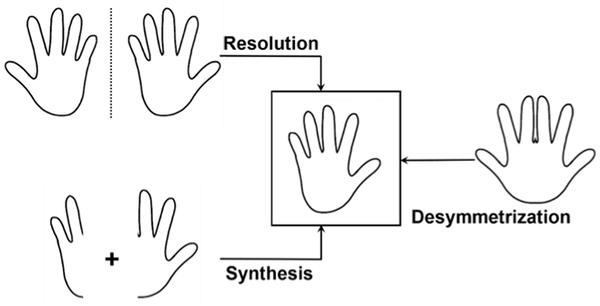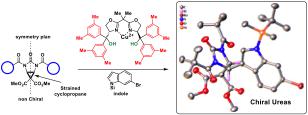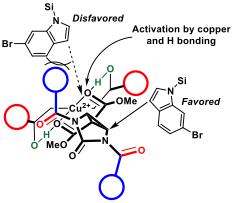New symmetry-breaking method opens way for bioactive compounds

A demonstration of chirality (credit: J. Waser/EPFL)
EPFL chemists have developed a new catalytic method for symmetry breaking. Published in Angewandte Chemie, the method can help synthesize important building blocks for bioactive compounds such as anticancer drugs.
Many chemical molecules can exist in nature together with their mirror counterparts; like hands, two compounds can be made up of the same atoms in the same overall structure but in opposite orientations, i.e. left-handed and right-handed. This phenomenon of symmetry is called “chirality”, and can give mirror counterparts (“enantiomers”) entirely different chemical properties. A famous and tragic example of chirality is thalidomide, which was originally sold as a mixture of both enantiomers. The problem was that one was a harmless sedative and the other highly toxic to fetuses, resulting in disturbing congenital deformities.
So today it has become imperative to synthesize compounds with what is known as high “optical purity”, which is a measurement of chiral purity: the degree to which a sample contains one enantiomer in greater amounts than the other. But because enantiomers have very small structural differences and identical stability, synthesizing one over the other is a very challenging task.

The three main approaches to accessing one enantiomer selectively: 1) Separate a mixture of the two enantiomers (resolution), wasting one of the enantiomers. 2) Synthesize selectively only one of the two enantiomers. 3) Use a "desymmetrization" of a non-chiral compound similar to the target. This is used less often, but it is particularly elegant as it can reveal chirality from an already relatively complex precursor by breaking the symmetry in only one simple transformation. Credit: J. Waser/EPFL
One way to do this is what chemists call "desymmetrization" of a non-chiral compound that is similar to the target molecule. This involves modifying a molecule so that it loses the symmetry elements that prevented it to be chiral.
Researchers at Jérôme Waser’s Laboratory of Catalysis and Organic Synthesis at EPFL have now developed a new desymmetrization strategy to access chiral building blocks containing urea sub-structures. Urea derivatives are important components of biomolecules such as biotin (vitamin B7) or bioactive natural products, such as the anticancer agelastatin A.

Ureas: important building blocks of bioactive molecules. Credit: J. Waser/EPFL
The researchers made two crucial innovations. First, they designed a non-chiral cyclopropane (three-membered carbon ring) precursor. This molecule offers enhanced reactivity and is ideal for reactions under mild conditions.
Second, the researchers engineered a new copper catalyst that can form an enantiomer of the desired product with high selectivity. The copper center binds and activates the cyclopropane precursor, causing its bonds to break. The precursor is then attacked by an indole, a molecule very important as structural element of bioactive compounds. As a result, the precursor loses its symmetry – and therefore becomes chiral – and can be used to selectively make the desired enantiomer.

Accessing chiral ureas from the desymmetrization of cyclopropanes using a carefully designed copper catalyst. To control the reaction at a single site, a special chiral ligand was used on the copper, bearing two alcohol groups as "hands" to grip the substrate (in green) and large groups (in red) blocking selectively regions of the space. Credit: J. Waser/EPFL

Tentative model rationalizing symmetry breaking.It is speculated that hydrogen bonds with the substrate will result in a rigid three-dimensional "chiral pocket", like the one of enzymes. In this pocket, one of the possible trajectories for opening the cyclopropane is blocked, resulting in a loss of symmetry and the formation of a single enantiomer. Credit: J. Waser/EPFL
Swiss National Science Foundation (SNSF)
Daniele Perrotta, Ming-Ming Wang, Jérôme Waser. Lewis Acid Catalyzed Enantioselective Desymmetrization of Donor-Acceptor Meso-Diaminocyclopropanes. Angewandte Chemie International Edition DOI: 10.1002/anie.201800494 and Angewandte Chemie DOI: 10.1002/ange.201800494